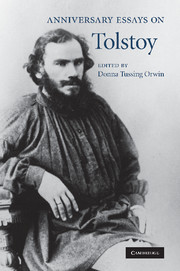Book contents
- Frontmatter
- Contents
- Acknowledgments
- List of contributors
- Introduction
- 1 Tolstoy and music
- 2 Sublime vision and self-derision: the aesthetics of death in Tolstoy
- 3 Tolstoy's peaceable kingdom
- 4 Leo Tolstoy: pacifist, patriot, and molodets
- 5 Leo Tolstoy's correspondence with Nikolai Strakhov: the dialogue on faith
- 6 The worm of doubt: Prince Andrei's death and Russian spiritual awakening of the 1860s
- 7 Tolstoy's spirituality
- 8 Tracking the English novel in Anna Karenina: who wrote the English novel that Anna reads?
- 9 Violence and the role of drama in the late Tolstoy: The Realm of Darkness
- 10 What men quote by: Tolstoy, wise sayings, and moral tales
- 11 The “proletarian lord”: Leo Tolstoy's image during the Russian revolutionary period
- Bibliography
- Index
4 - Leo Tolstoy: pacifist, patriot, and molodets
Published online by Cambridge University Press: 03 May 2010
- Frontmatter
- Contents
- Acknowledgments
- List of contributors
- Introduction
- 1 Tolstoy and music
- 2 Sublime vision and self-derision: the aesthetics of death in Tolstoy
- 3 Tolstoy's peaceable kingdom
- 4 Leo Tolstoy: pacifist, patriot, and molodets
- 5 Leo Tolstoy's correspondence with Nikolai Strakhov: the dialogue on faith
- 6 The worm of doubt: Prince Andrei's death and Russian spiritual awakening of the 1860s
- 7 Tolstoy's spirituality
- 8 Tracking the English novel in Anna Karenina: who wrote the English novel that Anna reads?
- 9 Violence and the role of drama in the late Tolstoy: The Realm of Darkness
- 10 What men quote by: Tolstoy, wise sayings, and moral tales
- 11 The “proletarian lord”: Leo Tolstoy's image during the Russian revolutionary period
- Bibliography
- Index
Summary
What if there were a war and nobody came? Bumper stickers in college towns all over the United States in the 1960s broadcast this slogan, but today, fifty years later, no end to war is in sight. Count Lev (Leo) Nikolaevich Tolstoy, advocate of conscientious war resistance and author of the greatest war fiction in modern times, hated war but understood its role in human life. He fought in two conflicts, the long-running battle against mountain tribes in the Caucasus, and the Crimean War. Born into a family of warrior aristocrats, with his oldest brother Nikolai already in the army, his decision to take up arms came naturally, and so, presumably, did his celebration of Russian martial spirit at the siege of Sevastopol. Yet the seeds of his later pacifism are evident in his earliest war stories. A draft of his first one, “The Raid” (1853), defines war as “murder,” while the patriotic “Sevastopol in December” (1855) calls it “blood, suffering, and death.” War seemed evil to him for religious reasons, and in the final chapter of “Sevastopol in May” (1855) he asks how “all those [Christians] who profess the same great law of love and self-sacrifice” could fight one other. In his old age, by then a world-famous pacifist, Tolstoy returned in Hadji Murat (published posthumously, 1911) to the Caucasian wars of his youth to depict them as an imperialist adventure by Russia. Yet this anti-war masterpiece contains his most sympathetic portrait of a warrior.
- Type
- Chapter
- Information
- Anniversary Essays on Tolstoy , pp. 76 - 95Publisher: Cambridge University PressPrint publication year: 2010



